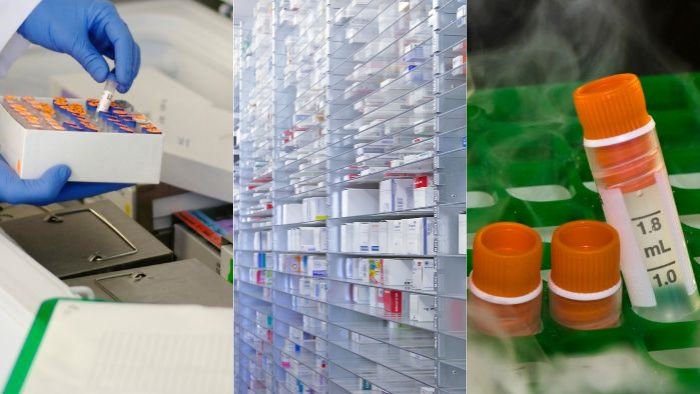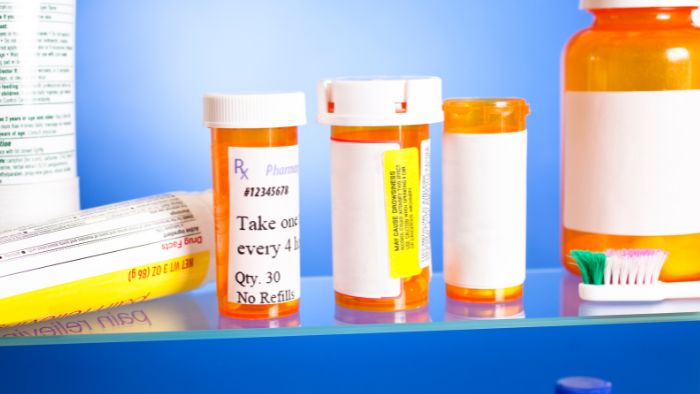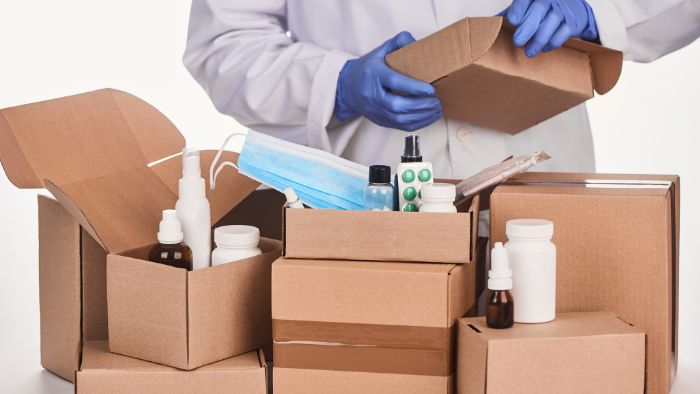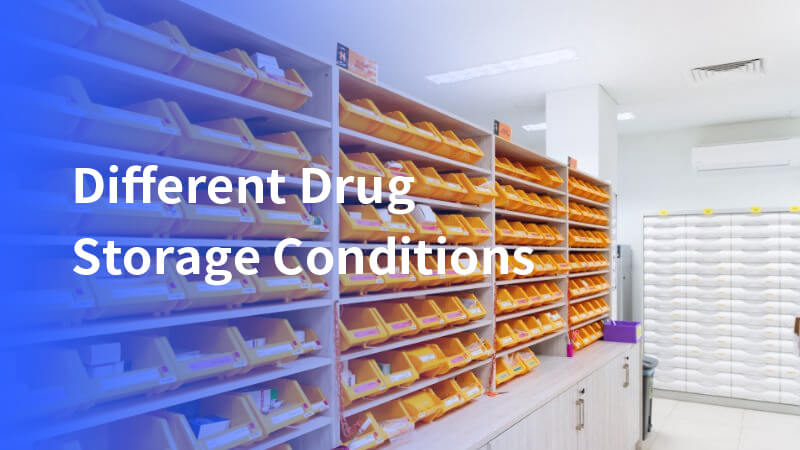When addressing drug storage, it is vital to understand the specific conditions required to maintain the stability and efficacy of pharmaceuticals. Proper medication storage conditions are essential to prevent the degradation of medications, which can result in reduced effectiveness or even harmful effects.
This article explores the various drug storage conditions, detailing the importance of temperature, humidity, light exposure, and gas environment control, and examines how labels play a crucial role in managing these conditions.
Basic drug storage conditions
Temperature control
Drug storage requires meticulous temperature control to ensure that medications remain effective throughout their shelf life. Ambient temperature can influence drug stability, as medications stored outside the manufacturer’s recommended temperature range can degrade and lose efficacy. There are three main temperature categories for drug storage:

- Refrigerated storage: Typically between 2°C and 8°C, refrigerated storage is crucial for many vaccines, biologics, and certain antibiotics. This temperature range helps preserve the biological activity of these sensitive medications.
- Room temperature storage: Generally considered to be between 15°C and 25°C, controlled room temperature storage is suitable for most oral medications, including tablets and capsules. Maintaining a stable room temperature prevents the degradation of these medications.
- Frozen storage: Below -20 °C, frozen storage is used for long-term preservation of certain biologics and complex molecules that require extreme cold to remain stable. This method is essential for preserving the integrity of these sensitive drugs over extended periods. Excessive heat can lead to the degradation of critical medications, posing serious risks to health.
Humidity control
Humidity levels can significantly impact the stability of pharmaceutical products. Controlling humidity is essential for preventing moisture-related degradation:
- Low humidity: Maintaining a low-humidity environment (below 30% relative humidity) is crucial for hygroscopic drugs, which absorb moisture from the air and can degrade or become less effective when exposed to high humidity.
- Moderate humidity: For most medications, a controlled environment with moderate humidity (30-50% relative humidity) is adequate. This range helps prevent moisture absorption while also avoiding overly dry conditions that could affect packaging materials.
- High humidity: Certain medications stored in liquid form or those in specific packaging might tolerate higher humidity levels. However, high moisture generally poses a risk of contamination and degradation, so it is less commonly used.
Controlling humidity is essential for maintaining drug quality, ensuring treatment efficacy and safety.
Light exposure
Exposure to light, especially UV light, can cause the breakdown of certain drugs. Controlling light exposure is essential for maintaining drug potency:
- Light-sensitive storage: Many medications, such as certain vitamins and antibiotics, are sensitive to light. These drugs must be stored in dark conditions or in opaque containers to prevent light-induced degradation.
- Light-stable storage: Some medications are stable when exposed to light and do not require special light-protection measures. However, general precautions are still taken to avoid prolonged direct sunlight exposure.
Gas environment
The presence of certain gases can affect the stability of drugs. Controlling the gas environment is crucial for certain sensitive pharmaceuticals:
- Inert gas environment: For drugs sensitive to oxidation, storing them in an inert gas environment, such as nitrogen, can help prevent oxidative degradation. This method is commonly used for injectable drugs and certain high-value biologics.
- Controlled atmosphere: Some medications benefit from storage in a controlled atmosphere with specific gas compositions to maintain their stability and efficacy. This might include reducing oxygen levels or controlling carbon dioxide concentrations.
Specific storage requirements for different types of drugs
Biological products
Biological products, such as vaccines and monoclonal antibodies, often require strict temperature control to remain effective:
- Cold chain requirements: These products must be stored and transported within a narrow temperature range (typically 2°C to 8°C) to preserve their biological activity. Cool storage is crucial in various fields and medical settings to ensure these products remain within their recommended temperature ranges, especially where traditional refrigeration may not be available.
- Light and humidity protection: Many biologics are sensitive to light and humidity, necessitating storage in dark, dry conditions to prevent degradation.
Antibiotics
Antibiotics have specific storage needs to maintain their potency and prevent microbial contamination:
- Temperature control: Most antibiotics are stable at room temperature, but some may require refrigeration.
- Humidity control: Protecting antibiotics from high humidity is crucial to prevent moisture absorption and degradation.
- Light protection: Certain antibiotics, such as tetracyclines, are highly sensitive to light and must be stored in opaque containers.
Chemical drugs
Chemical drugs, including tablets, capsules, and solutions, have varying storage requirements based on their formulation:
- Temperature and humidity: These drugs generally require stable room temperature and moderate humidity conditions to maintain their stability.
- Light exposure: Some chemical drugs are sensitive to light and should be stored in dark conditions to prevent degradation.
Liquid medications
Liquid medications, including syrups and injectables, have unique storage needs to prevent contamination and ensure potency:
- Sealing and temperature control: Proper sealing and temperature control are essential to prevent contamination and maintain the effectiveness of liquid medications.
- Humidity and light protection: These medications must be stored in environments that protect against excessive humidity and light exposure.
Role of labels in drug storage
Essential label information
Labels are critical in drug storage, providing necessary information to ensure proper handling and storage conditions:
- Storage temperature: Labels indicate the required storage temperature range, guiding the correct placement of the medication. Adhering to the storage instructions provided by manufacturers is crucial for maintaining the efficacy and safety of medications.
- Humidity requirements: Information on the label helps in maintaining the appropriate humidity levels for the stored drug.
- Light conditions: Labels specify whether the medication should be kept in the dark or away from direct light, ensuring protection from light-induced degradation.

Labels in drug management
Labels play a significant role in drug management, ensuring proper inventory control and safe usage:
- Batch management: Labels provide batch numbers and manufacturing details, aiding in inventory control and traceability.
- Expiration dates: Clearly marked expiration dates on labels ensure that medications are used within their effective period, preventing the use of expired drugs.
- Usage instructions: Labels include critical usage instructions and precautions, guiding healthcare professionals in the proper administration of medications.
Advanced labeling technologies
Innovative labeling technologies enhance the management of drug storage conditions:
- Temperature-sensitive labels: These labels change color or display a warning if the drug has been exposed to temperatures outside its recommended range, ensuring the medication’s integrity.
- Humidity-resistant labels: Designed to withstand high humidity environments, these labels remain legible and intact, providing crucial information regardless of storage conditions.
- UV-protective labels: These labels protect against UV light exposure, preserving the efficacy of light-sensitive drugs.
Labeling plays a pivotal role in the storage of medicines, and labeling equipment is an indispensable machine, Viallabeller provides first-class pharmaceutical labeling machines, and a series of labeling solutions, such as pill box labeling, pill bottle labeling ……
Monitoring and managing storage environments
Temperature monitoring devices
Effective temperature monitoring is essential to maintain drug storage conditions:
- Temperature data loggers: These devices record temperature data over time, ensuring that storage conditions remain within the specified range.
- Real-time monitoring systems: Advanced systems provide real-time temperature monitoring and alerts, allowing for immediate corrective actions if conditions deviate.
Humidity monitoring devices
Controlling humidity levels is vital for drug stability:
- Humidity sensors: These sensors continuously monitor humidity levels, ensuring they remain within the acceptable range.
- Data recording and alarm systems: Integrated systems record humidity data and trigger alarms if levels exceed specified limits, preventing potential drug degradation.
Light exposure monitoring
Protecting drugs from light exposure is crucial for light-sensitive medications:
- Light intensity monitors: These devices measure the intensity of light in storage areas, ensuring that light-sensitive drugs are adequately protected.
- Light protection measures: Implementing light-blocking materials and UV-protective films can further safeguard medications from harmful light exposure.
Gas environment monitoring
Maintaining the appropriate gas environment ensures the stability of sensitive drugs:
- Oxygen level monitors: These devices measure oxygen levels in storage areas, preventing oxidative degradation of sensitive drugs.
- Inert gas control systems: Systems that regulate the concentration of inert gases, such as nitrogen, help maintain optimal storage conditions for certain pharmaceuticals.
Consequences of improper storage and solutions
Common storage issues
Store medications properly to avoid various issues:
- Drug ineffectiveness: Medications may lose their potency, rendering them ineffective in treating conditions.
- Degradation and contamination: Exposure to improper conditions can cause drugs to degrade or become contaminated, posing risks to patient safety.
Preventative measures
Implementing preventative measures can mitigate storage issues:
- Proper labeling and identification: Ensuring all medications are accurately labeled with storage conditions helps maintain their stability.
- Regular inspections and maintenance: Routine checks and maintenance of storage environments prevent potential issues and ensure compliance with storage requirements.
Corrective actions
When storage conditions are compromised, prompt corrective actions are necessary:
- Drug recall and disposal: Removing compromised medications from the supply chain and safely disposing of them prevents the use of ineffective or unsafe drugs.
- Corrective and preventative actions (CAPA): Implementing CAPA procedures addresses the root causes of storage issues and prevents recurrence.

Conclusion
Drug storage is a critical aspect of pharmaceutical management, requiring careful control of temperature, humidity, light exposure, and gas environment to ensure the stability and efficacy of medications. Labels play a vital role in conveying essential storage information and managing drug inventories effectively.
Proper monitoring and maintenance of storage conditions help prevent degradation and ensure that patients receive safe and effective medications. The comprehensive approach to drug storage highlights its importance in the pharmaceutical industry, ensuring that medications are preserved under optimal conditions.







